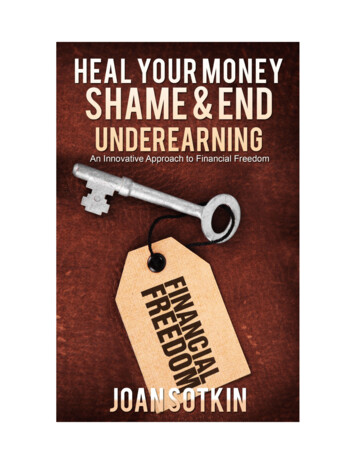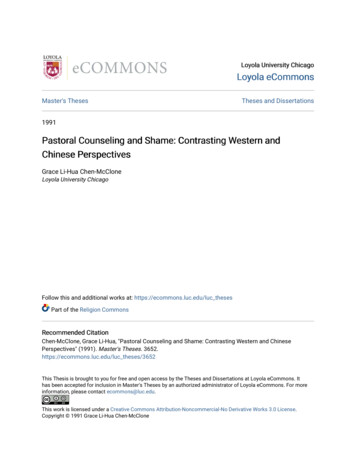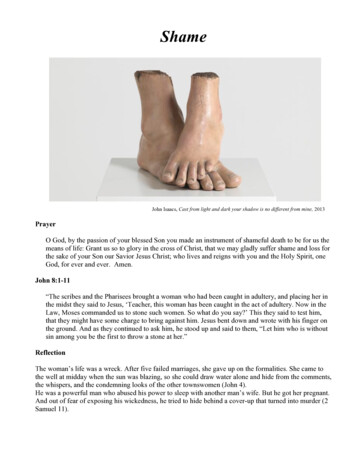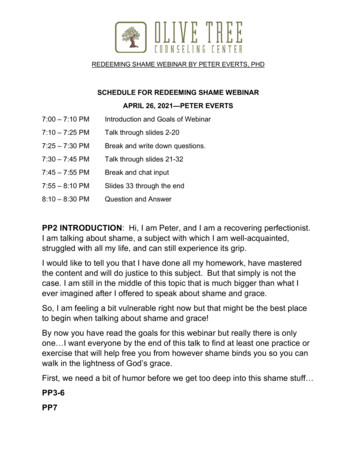
Transcription
HEAL YOUR MONEY SHAME &END UNDEREARNINGAN INNOVATIVE APPROACH TO FINANCIAL FREEDOMby Joan SotkinCopyright 2017 by Joan SotkinAll rights reserved. No part of this publication may be reproduced in any formwithout written permission from the publisher, except for brief quotationsembodied in literary articles of reviewsPublished by Prosperity Place, Inc.www.ProsperityPlace.com
WHY I WROTE THIS BOOK I wrote this book because I see so many people suffering financially, as I once did.Over the years, as I shared what I was learning on my own journey to health andprosperity, I saw that what I was sharing had a positive impact on many people.Now, I want to share what I’ve learned with you.For over 25 years, I’ve been examining the relationship between money andemotions. In my award-winning book, Build Your Money Muscles: Nine SimpleExercises for Improving Your Relationship with Money, I described the five mainemotions that people act out through their finances: Aloneness, Shame,Deprivation, Anger, and a Sense of Being Trapped.This book focuses on shame and how and why it can be affecting your finances.Shame is often acted out through underearning – and overearning, chronicdebting, compulsive shopping, late bill paying and poor investment decisions.Accompanying shame is often low self-esteem, guilt, feeling invisible, inadequate,or defective.Be learning to recognize the shame, you can also learn how to replace it withemotions that will be expressed through comfortable life stories.At the end of this book, you will find links to other resources that I have madeavailable.If you find this book to be of value, I hope you’ll visit www.ProsperityPlace.comand become part of my community.3
WHY YOU SHOULD READ THIS BOOKHabitual shame can be one of the main forces behind your money problems. Thisbook will help you understand why.With this understanding, you will be able torelease your shame and move towards a more prosperous future.This book is a must-read for anyone who has financial problems, considersthemselves to be an undereaner, carries a lot of debt, avoids financial tasks, orhas a difficult relationship with money. The theories and solutions described hereare unique and innovative and have helped thousands of people overcomefinancial discomfort.If you are ready to move forward financially, this book will provide you with a keyto what is holding you back.“You provide a unique approach to understanding the whys of moneybehavior. Armed with the information you provide, I’ve been able to finallystart taking care of my money.” Lorna Davila, California4
TABLE OF CONTENTSHow You Create Your Life Stories. 6What Shame Is . 9Feelings Are Reflected in Finances . 11The Fantasy Bond . 14There Are Solutions . 16Four Basic Steps . 18A Side Effect of Releasing Shame . 20How to Recognize Your Feelings . 21The Power Word Technique . 25Let Go of Critical Self-Talk . 27How to Develop New Emotional Responses . 30Overcome Your Resistance . 32How to Stop People Pleasing . 35Using Sound and Writing to Heal Your Shame . 37The Shame of Debt . 40Create New Responses . 42Increase Your Financial Literacy . 44In Conclusion . 46Weekly Information and Interviews on The Prosperity Show Podcast . 47Connect with Joan . 48About the Author . 49Other Books & Programs by Joan Sotkin . 505
HOW YOU CREATE YOUR LIFE STORIESBefore we get into the specifics of how shame is affecting your finances, let’s lookat how you create your life stories, which includes your financial condition.First of all, your life stories are an extension of your habitual thoughts, beliefs,and emotions. In other words, how you think, what you believe, and youremotional response to life are what inform your decisions, stimulate yourbehaviors and determine the quality of your life outcomes.And here’s the important point: Your habitual thoughts, beliefs, and emotions areusually the result of your early childhood experiences.As an example, let’s look at a fellow named Jim whose father was extremelycritical and never satisfied with what Jim did, and his mother, althoughsympathetic, never stood up for Jim during her husband’s tirades against his son.As an adult, Jim was always chasing one of his many dreams, but never realizedany of them. At age 40, he felt burdened by his credit card debt and livedpaycheck to paycheck, always worrying about his finances. On the rare occasionswhen he and his wife accumulated some savings, something would happen, likethe car breaking down or one of their kids getting sick, and they would have touse their savings and add to their credit card debt.Jim felt like a failure. He wanted to be a responsible husband and father, but healways felt like he was living life on the edge.Was Jim a victim of life’s circumstances? He often thought so. But, when Jimlooked at his thoughts and emotions, he was able to see that, based on hisupbringing, he expected to fail and was living up to his own expectations. Hecame to understand that his father was still with him in his head, always criticizingand stimulating feelings of failure and shame.Jim lived in a shamed state of being and his finances were congruent with thisstate of being. In order for the outcome of his life stories to change, he wouldhave to alter his state of being, which would mean letting go of his habitual6
critical thoughts, his beliefs about himself as a failure, and his negativeexpectations.Jim learned that emotions hidden inside of him were the energetic force behindhis life stories, and that shame was a core emotion he carried with him.By using techniques such as those you will learn here, Jim was able to graduallymodify his self-concept and begin to value himself. An improved self-image wasreflected in an improved financial condition, and he felt better about himself andhis life. At the same time, his home life became considerably more peaceful andrewarding emotionally.In a nutshell, here’s the theory that Jim’s story illustrates: You create your lifestories in order to express hidden emotions. If your life stories often end indisappointment, then long-repressed feelings of disappointment are expressingthemselves through your life stories. If betrayal is one of your emotional themes,then you will experience a series of interactions where betrayal is the payoff.And if shame is one of your core feelings, many of your life stories will haveelements that allow you to feel the shame, and you’ll draw in the people youneed to perpetuate the shame. This could be in the form of a critical spouse, boss,co-worker, or someone in your social circle.In addition, your life stories will be peppered with shame-based elements such asunderearning, carrying endless credit card debt, bouncing checks, and gettingfired. Or, you may experience a series of failed relationships, people gossipingabout you, or any situation that causes you embarrassment.Perhaps you can imagine that you have threads of emotion around which thefabric of your life is woven and these threads of emotion exist, on one level oranother, in all of your life stories.Once you understand this, then when you wonder why something appears to behappening to you, you can ask, “What is it that this situation is allowing me toexpress?” By examining the feelings that a situation stimulates for you, you canidentify the force behind the story and take steps to express the feelings rather7
than holding them in and having them recycle over and over again through yourlife stories.At this point, you might say, “But I have a hard time recognizing my feelings andI’ve never been very good at expressing them.” If shame is one of your motivatingemotions, that’s most likely true, because one of the ways that children areshamed is by having their feelings invalidated.Most people have trouble expressing their true emotions because they havenever learned how to safely and authentically feel their feelings. But with thetechniques outlined here, you’ll be able to get in touch with long repressedemotions, express them, and move on with your life.8
WHAT SHAME ISWe all have shame. Actually, we need some shame. It’s what keeps us fromrunning around naked, lying about everything, or behaving in unsociable ways.This kind of shame is called healthy shame.Toxic shame, on the other hand, hurts us and keeps us from expressing ourselvescreatively and living up to our potential. Toxic shame is a painful feeling aboutoneself as a person, stemming from the belief that there is something inherentlywrong with who you are.Toxic shame is not the same as guilt. Guilt is the result of feeling bad aboutsomething you did, while shame results from feeling bad about who you are.Shame begins early in life and has many causes. You most likely carry shame if youare A child or grandchild of an alcoholic A victim of physical, emotional, or sexual abuse A member of a minority group including ethnic, religious, or racial,groups, or if you are gay, lesbian, bisexual or transgenderBeing a woman in a culture that places a higher value on men or being a man in aculture that values women leads to shame.If you were out of the ordinary in any way as a child—really short or tall, verypoor or very rich, or disabled—anything that made you stand out from a crowd—then you most likely harbor feelings of shame.You’ll also carry shame if your parents were narcissistic and expected you to meettheir needs. Or if, like Jim, you had a very critical parent for whom you were nevergood enough. Or, if you were rarely touched as a child.Shame also comes from negative family rules that stifle or prohibit the healthyexpression of emotions, like boys don’t cry. In my family, my father often wouldsay, “Sotkins don’t feel.” That was a tough one since I wanted to be part of the9
Sotkin family yet I knew I was feeling a lot, even though I couldn’t express myfeelings.Then there are the messages from adults that children often get, like “Shame onyou,” or “I’m disappointed in you.” And, of course, there is the shameperpetrated by religion. The whole concept of sin stimulates feelings of shame.In his book, Healing the Shame that Binds You, John Bradshaw says that shamecomes from separation from our authentic selves. Each time a child’s authenticfeelings are invalidated, the authentic self is shamed. And each time you engagein people pleasing or give in to someone because you’re afraid to make waves,that causes internal shame because you are invalidating yourself.The list of situations that lead to shame goes on and on. It’s no wonder that alarge percentage of our population is shame-based, and this acts itself out inmany ways.Because shame is a painful experience, people will self-medicate feelings ofshame through compulsive behaviors and addictions. I’d venture to say that thereis no such thing as a compulsive spender or debtor or alcoholic, drug addict orrageaholic who isn’t shame based. Shame also forms the foundation for habitualviolence and treachery.10
FEELINGS ARE REFLECTED IN FINANCESRemember I said that you create your life stories in order to act out hiddenemotions. Well, if shame is one of those hidden emotions, it’s going to findexpression, one way or another, and one of the most common ways is throughyour finances.Why is this? Because money has no meaning or power by itself. Its energy comeswhen it passes between two people or entities. Therefore, you can say thatmoney is a symbol of the energy of relationship, and how you deal with money ishow you deal with your relationship with yourself and others.If you’re ashamed of yourself and your position in life, that’s going to show itselfthrough your finances in many possible ways. Underearning, late bill paying,habitually losing money through investments, lending money that isn’t paid back,and, of course, chronic debting and compulsive spending are all examples offinancial behaviors stimulated by shame.Bankruptcy, foreclosure, poverty, using food stamps or being on welfare, highcredit card interest rates and penalty fees, and a low credit score all allow one toexpress shame.I’ve done a lot of reading about shame and how to let go of it, but I have neverseen anything substantial about the connection between shame and financialdiscomfort. Yet, after years of working with clients, it is obvious to me that shameis one of the main feelings acted out through money.You can be sure that your financial behaviors have a shame base if: You cringe every time you look at your bank balance You avoid balancing your checkbook or keeping track of your cash flow. When bills arrive, you feel a rush of emotion as you open the envelope oryou just push the envelope aside and conveniently forget about it. You feel inadequate because you can’t buy what you would like for yourselfand your family.11
You’re also dealing with shame if:You have to call creditors to make payment arrangementsCollection agencies call you oftenYou have issues with the IRSYou create financial rescue dramas where family or friends have to give orlend you money You live from paycheck to paycheck You often compare your financial position to that of your friends orneighbors You need to control your spouse’s spending or often judge their earningability Here’s one that may surprise you: People who are focused on making millions ofdollars, when millions of dollars are way beyond their financial experience, areusually expressing shame. What they are saying is, “If I have a lot of money, I’llhave value and I’ll be worth something.” Money, it seems, is their cure for feelingdefective. The underlying belief might be, if I have more money than other peopleI know, they won’t be able to criticize or shame me.It amazes me that when I ask people why they want millions of dollars, many willanswer that they want the money to give it away. This is a way of saying if I’mreally good, people will love me, and I can be good (and not ashamed) if I help theunfortunate.Then there is the situation where people often say that they need money to solvetheir problems. That’s really a way of saying, I’m not having my needs met, asituation that often coexists with shame.Or for those who crave material goods and can only feel good with designer labelswhen they have to stretch way beyond their means to buy designer goods, thereis the hope that these expensive items will make them seem valuable in the eyesof the world.12
On the opposite end of the spectrum are people who are stingy with their money,rarely sharing it with others and always obsessing about paying the least amountof money for anything they buy.Does this mean that everyone who is frugal is shame based? No. But virtually allfinancial behaviors can be a protection against shame or an expression of shame.For those fortunate few who were brought up in emotionally healthy homes,financial behaviors may not be stimulated by shame. But such people are rare.13
THE FANTASY BONDThere’s one more issue that I’d like to introduce before we proceed to techniquesfor releasing shame, and that is what is called by psychiatrist Robert Firestone TheFantasy Bond, an illusion of connectedness that a child creates in relation to acaregiver who is shaming the child.The fantasy bond is formed early in childhood when one or both parents do not,or don’t have the capacity to, treat the child in a loving way. It can start as early asfeeding time for the new infant if the mother is unable to give the child theintimate contact it needs. It continues when there is little or no affection.Instinctively, the child feels that something is wrong with it because the parent orparents can’t love him or her.When children are abused in any way, they tend to blame themselves for theabuser’s behavior, feeling that there is something wrong them and that’s whythey are being abused. They do this because blaming the parent is too dangerousbecause the child perceives that it could be abandoned and knows it can’t survivealone. So, because of the shame induced by the abuse, the child creates a fantasybond, clinging to the illusion that someone who loves and protects them is therefor them.People who are victims of spousal abuse often explain away their abuser'sbehavior with statements like “I know he treats me badly, but he loves me.”When I first read about the fantasy bond, I thought about how people create afantasy bond with their creditors. They think that the credit card companies aredoing them a favor by letting them use credit and keep coming back for abuse inthe form of high fees and interest rates and an unforgiving attitude towardstemporary financial troubles.One of my clients, who was deep in debt, said to me one day, “My angels sent meanother credit card.” She was sure that getting the credit card, which would onlyincrease her debt burden, was something positive. This was a fantasy bond.14
People also create fantasy bonds with stores, charities, and sales people. Theirlack of self-esteem and need for love is so strong, that they will stretchthemselves financially to please the person or entity with whom they have afantasy bond. Compulsive shoppers often form fantasy bonds with the storeswhere they do their shopping, specific clothing lines, or the credit card companieswho support their addiction.And at the base of each of these fantasy bonds is shame.15
THERE ARE SOLUTIONSI hope you can see how, if you have any financial discomforts, that shame can beone of the core emotions that you’re acting out through your money.So now, it’s time to look at the solution—how you can heal the shame and beginto build a solid financial foundation. By following the steps that I’m going to walkyou through, you will be able to recognize when shame is affecting your financesthen take specific actions to let go of the shame and develop a healthier selfconcept which will be reflected in healthier finances.I suggest that you listen to this audio all the way through once, then come back toeach of the techniques and learn to use them one at a time.Keep in mind that letting go of deeply rooted shame takes time as you developlevels of awareness and understanding followed by the release and replacementof long-standing thinking and feeling habits.It would be great if all you needed to do was follow a few simple instructions,then suddenly your life would change, money would come rushing in, and all ofyour financial fears and discomforts would magically dissolve.But that’s not how it works. If you react like most human beings do, you are goingto resist any kind of significant change. We all do it. Most people would ratherhold on to what they know, no matter how uncomfortable, than to step into theunknown and establish a new state of being.As you let go of your shame, your life is going to change in unpredictable ways.People will respond to you differently and, in return, you will have to develop newresponses to them.For example, if you’ve been somewhat shy or distant in order to protect yourselffrom being shamed, there’s a good chance that you’re going to feel moreconfident with people and want to establish stronger social ties. As a result,people are bound to respond to you in a positive way, something you may not beaccustomed to. You’ll be moving into unfamiliar territory.16
At this point, forming fantasy bonds with new people you meet would be natural,so it’s a good idea to be aware of this tendency and make an effort to establishauthentic relationships with people.In another scenario, if you have been somewhat controlling as a way of protectingyourself, you’ll have to learn how to develop team skills and overcome your fearof connecting with people in an authentic way.At the same time, family or friends may not understand your new way of beingand they may try to push you back to your old familiar self. They will do thisunconsciously in order to protect their own position. Being aware of thispossibility will help you work through the various stages of your healing.Your attitude towards altering your state of being is important. If you understandthat you are going through a process and that there is a learning curve, thenperhaps you will be willing to take some chances and try new behaviors. Peoplewho are shame-based are often afraid of making mistakes. As you heal, it helps torealize that there are no mistakes, there are only learning opportunities and thatyou have the ability, if you give yourself a chance, to step out of your past andinto a comfortable, prosperous future.17
FOUR BASIC STEPSHealing your shame involves four basic steps.Step 1:The first is to recognize the emotion and when it is triggered for you. There will besome obvious moments, such as when an authority figure criticizes you or youbounce a check, and some more subtle ones, such as when you see an envelopethat you know contains a bill.Step 2:The second step in healing the shame is to expresses it. Emotions, by their nature,want to be expressed. John Bradshaw calls them e-motions or energy in motion.Like it or not, everyone responds emotionally multiple times a day, every day. Andif the feelings aren’t expressed, but are pushed down and held in or buried bydrinking alcohol, smoking, doing drugs, shopping or some other mood-alteringactivity, then they get stuck in the body/mind system. Try to imagine that thereare little bits of shame stuck in each of your trillions of cells waiting for theopportunity to express themselves.As the shame builds up in your cells, you’ll create life stories that provide theopportunity for expression of the shame, such as causing an accident, bouncingchecks, or getting fired from a job.If you keep holding in the shame, it continues to build up. Eventually, it canexplode via a physical symptom such as pain, high blood pressure, or digestivedisturbances, or emotionally as chronic depression, manic behavior, or rage.If you’ve been holding in your shame for a long time, you’ll probably resistexpressing it. After all, it’s your habit to hold it in. You know how to do that awhole lot better than you know how to express it. So I’m going to walk youthrough this process, one tiny step at a time.18
Step 3:The third step in healing your shame is to develop new emotional responses tofamiliar situations that habitually generate shame for you.For example, if, when talking about money with an authority figure or with yourspouse, internally you feel like a child expecting to be criticized, with practice youcan alter that response and feel like an intelligent adult when discussing money.Or, when someone close to you behaves in an irresponsible manner or acts outthrough addictive behaviors such as drinking, gambling, or overspending, youdon’t have to feel responsible for their dysfunction and you can learn not to takewhat they say or do personally.Step 4:The fourth step involves developing financial management skills and discipline. Bytaking care of your money and making wise financial decisions, you can feel goodabout yourself and your behaviors.That’s a condensed version of how to transform and release your need to hold onshame – awareness, expression, new emotional responses, and learning financialmanagement skills, and we are going to apply the steps in a moment.19
A SIDE EFFECT OF RELEASING SHAMEBut first, there’s something I’d like you to understand. Because your shame hasbeen building up for a long time, once it is given an avenue of expression, some ofit may come rushing out. In my mind, I see the image of people waiting in line forthe opening of a store that is offering a fantastic price on a prized item. When thedoors finally open, the people rush into the store like a giant wave coming onshore. After the initial wave, things quite down a bit and people continue to comeinto the store, but without the chaos and rush.The first rush of the shame exiting your body/mind system can feel intense,especially if you tend to hold in your feelings as a general rule. Your first instinctwill probably be to stop the rush of feeling by drinking, eating, shopping, smoking,or all of the above. The longer you can resist this kind of behavior, the sooner theinitial wave of emotion will pass and the release of shame can proceed in a moreorderly manner.As you become more adept at one or more of the shame-release techniques youare going to learn shortly, you will most likely find that you automatically begin toexpress additional feelings. You might even start crying, screaming, or poundingon something – hopefully something soft—like a pillow. Emotions have a lot offorce and the first wave can be strong.The good news is that when the feelings start coming, even if they areuncomfortable, you can experience a sense of aliveness because you’re beingauthentic and not holding in your true expression.This may all seem like a lengthy introduction when you are anxious to get rid ofyour shame, but necessary so you understand the process and what you are mostlikely to experience.20
HOW TO RECOGNIZE YOUR FEELINGSAs I said, the first step in healing your shame is to recognize it. To develop yourawareness. Long-standing shame has most likely been integrated into your entirebeing, making it, at times, difficult to recognize when it is trying to express itself.Let’s start by learning to recognize the feeling of shame as it expresses itselfthrough your body-mind. Feelings don’t just happen in your head. There areactually physical substances called neuropeptides that latch themselves on tocellular receptors that are located throughout your body. This allows you toexperience your feelings in many places throughout your body.So having an emotion is not the same as a thought. It is actually a kinestheticexperience that can be located anywhere in your body. Anxiety is a perfectexample. When you are anxious, there are physical sensations such as rapidheartbeat, an overall feeling of discomfort or jitteriness, or actual shaking that canbe found in your arms, legs, and other body parts.Love is an emotion that is often experienced in the heart area. There can also berushes of emotion felt throughout the body. Those are the physical, kinestheticexperience of love.Shame too is something that you experience throughout your body-mind. WhatI’d like to show you is how to actually stimulate the feeling of shame so you canfamiliarize yourself with its presence within your physical system.Let’s start by picking something relating to your money that makes youuncomfortable. Perhaps one of the following will do this for you: Looking at your bank statement or the balance in your checking accountPaying your bills or not paying your billsPaying your credit card bill late and getting slammed with late fees.Bouncing a checkThinking about the money you oweThinking about bad investments you have made21
Ok. Do you relate to one of these? Or perhaps you thought of something else.Choose one.Close your eyes and get a clear picture in your mind of the financial situation.Now scan your body looking for any discomfort. Pay attention to your chest, yourabdomen, your shoulders, and your head. Do you feel a heaviness, tension, agripping feeling or another form of discomfort? Perhaps you can recognize asense of sadness or even depression. Perhaps you feel as if you want to hide orthat your body is contracting. You may feel a physical ache or pain. Notice wherein your body you’re having these sensations.Are the sensations localized or is there a general, overall experience ofdiscomfort?What you’re experiencing is emotion and most likely it’s shame or has acomponent of shame, as it is expressing itself through your body/mind.To illustrate how you can change emotional states, I’m going to give you a quickway to alter the feeling so you won’t be afraid to become aware of your feelings.Focus on one of the areas where you’re feeling the heaviness or otherdiscomforts.Put your hand over the area and say aloud with me, I am so uncomfortable. I amso uncomfortable. I am so uncomfortable. Now take a deep breath in and out.And another. And another. Now say three times, I am releasing my discomfort, Iam releasing my discomfort, and take three more breaths. Scan your body againand see if there has been a shift. Most likely there has been. How much of a shiftwill vary from person to p
In his book, Healing the Shame that Binds You, John Bradshaw says that shame comes from separation from our authentic selves. Each time a child's authentic feelings are invalidated, the authentic self is shamed. And each time you engage in people pleasing or give in to someone because you're afraid to make waves, that causes internal shame .










